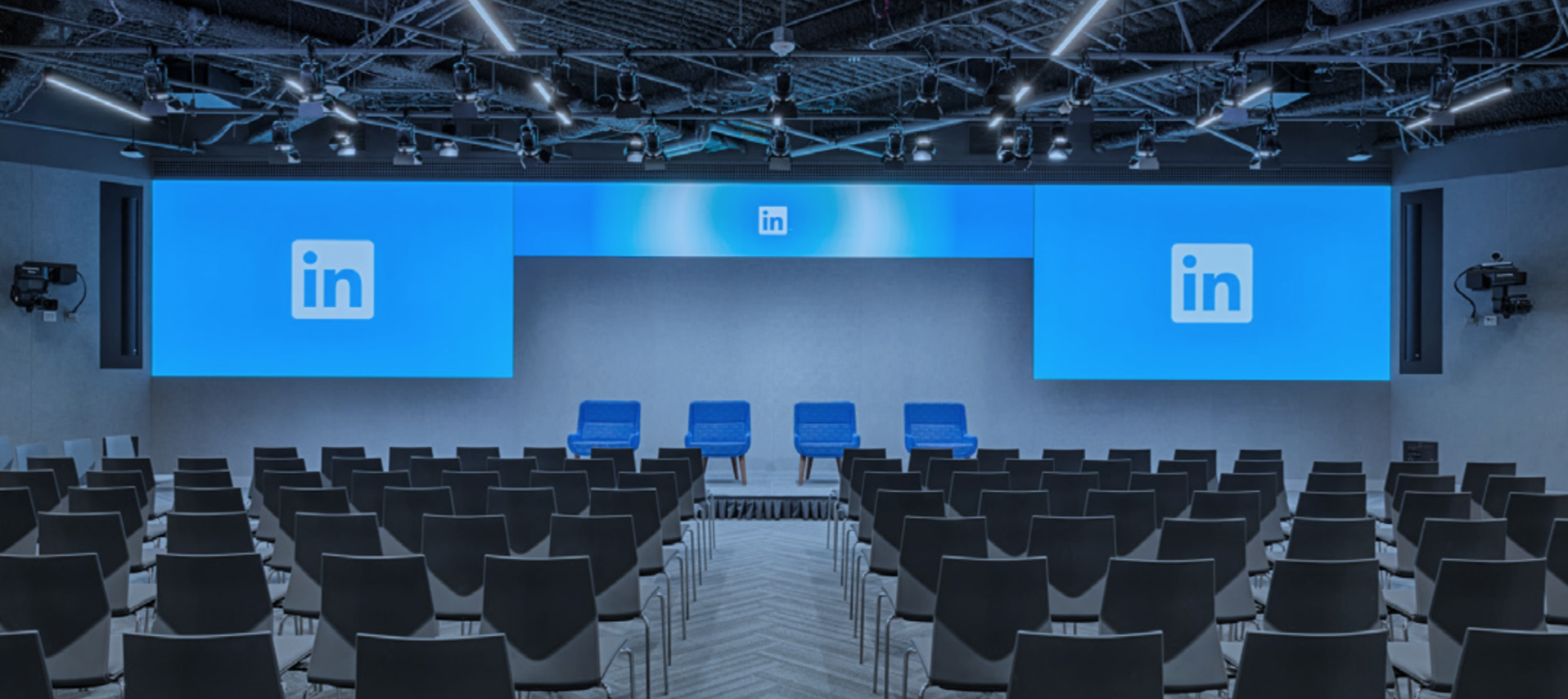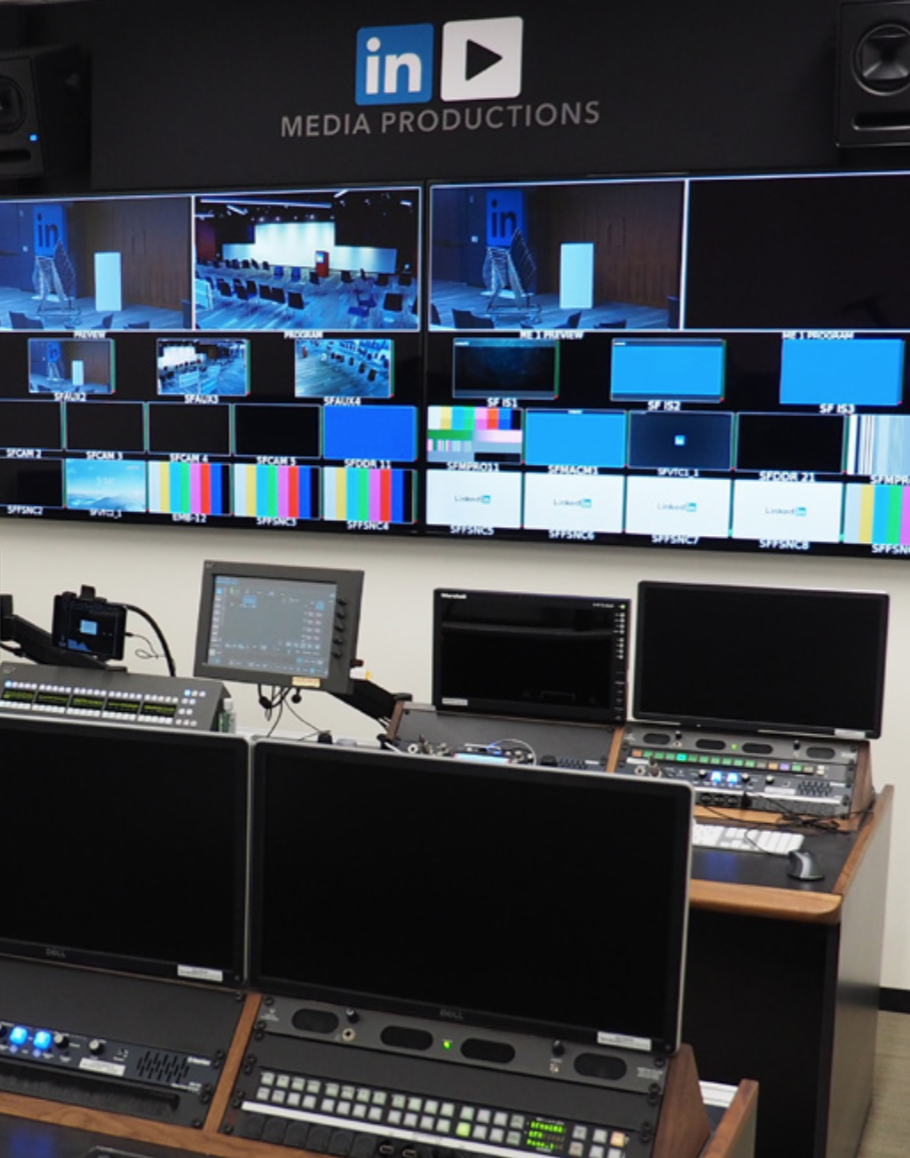Q-SYS Connects LinkedIn’s Four CA Campuses

As one of the world’s fastest growing social media platforms, LinkedIn has become an essential part of how more than 500 million people build and curate their business networks. LinkedIn has applied a belief in fast, efficient and flexible networking by enlisting Q-SYS to help achieve advanced integration within its large multipurpose meeting rooms across multiple corporate campuses.
Within each of LinkedIn’s four Californian corporate locations, large multipurpose meeting spaces are used for all-hands gatherings, hosting discussions and presentations spanning multiple sites. But in order to achieve faultless communication between campuses, along with centralized control and production, it needed an AV infrastructure with greater flexibility. For systems integrator David Carroll Associates (DCA), this required deep design considerations.
With all-hands meetings taking place across multiple corporate sites, LinkedIn required a system that would not only enable discussions to take place easily, but would eliminate the acoustic challenges of broadcasting from large, reverberant, reconfigurable multipurpose rooms. The chosen solution also had to be able to manage and convert multiple sources and formats while accommodating a high channel count density. The system needed to be designed for today’s standards like bridging between native and bridge networks like Dante. Equally, it needed to be ready for any future standards that might emerge, including AES67 for audio-over-IP interoperability. Finally, the system had to be user friendly, so that LinkedIn staff members were comfortable using it immediately and with minimal instruction.

“This was very much a ‘ground up’ project focused on moving our facilities toward IP,” said Gary D. Schneider, global production systems lead for LinkedIn Media Productions. “We quickly discovered that Q-SYS was the ideal bridge between the various technologies.”
DCA and LinkedIn decided to implement Q-SYS within the company’s San Francisco headquarters, its Middlefield campus in Mountain View, CA, and its Maude campus in Sunnyvale, CA. A fourth location, Pastoria Avenue, will follow imminently. The intention is to connect all of the facilities, allowing for the maximum flexibility of audio, video, and control processing and management—both for current and possible future requirements.
Each of the four locations currently feature QSC Integrated Core 500i processors. These Cores each have the capability of accommodating eight Q-SYS input and/or output cards. The channel count may be further expanded by the addition of Q-SYS I/O Frames and other Q-SYS peripheral devices.
A closer examination of the installation in San Francisco underlined the advantages of a Q-SYS Platform backbone. Work at this location focused on a large meeting room featuring such equipment as a Cisco videoconferencing system, a number of wireless microphones enabled with Audinate’s Dante media networking technology, and a Yamaha CL3 console for audio mixing.
A daily selection of features, industry news, and analysis for AV/IT professionals. Sign up below.
“In San Francisco, most of the sources were analog or AES digital, but the live-sound mixer only had a few analogue inputs,” said John Brenneis, lead design engineer at DCA, who worked intensively on the LinkedIn project. A solution immediately presented itself courtesy of Q-SYS, specifically the high channel-count density that its Intel-based Cores support. “The combination of Cores and Q-SYS I/O peripherals were used to convert these various formats to and from Dante to allow mixing to take place.”
Eventually, LinkedIn expects to route audio between campus sites via AES67. As of April 2017, Q-SYS Designer software supports AES67-standard interoperability, which LinkedIn plans to implement into its campuses.
Enabling basic two-way communication is one thing, but ensuring it sounds great is another challenge entirely. When all-hands meetings take place in large, often reverberant spaces, it’s easy to run into intelligibility issues. To ensure a seamless two-way communication experience, DCA specified Q-SYS with its third-generation acoustic echo cancellation (AEC) technology, which ensures that all audio is delivered with pristine intelligibility. The room used software-based AEC processors within Q-SYS to provide more than a dozen portable and fixed microphones in each room before being mixed into the PA and the videoconference codec. “We’ve tested acoustic echo cancellation from all the major DSP manufacturers,” Carroll said. “We noticed that the AEC from Q-SYS offered very natural response and no gating artifacts.”
In addition to “pure” audio processing duties, Q-SYS is being used to convert embedded audio from SDI video signals output from a Grass Valley Router into Dante for mixing on the Yamaha desk. Analog mics and line inputs from the Cisco videoconferencing system codecs can also be routed out on Dante via Q-SYS.
“Above all, we needed a platform that could handle conversion between all of the various audio formats—analog, AES, Dante, and AES67—and that is what we have achieved with Q-SYS,” Brenneis said.
With the AV networking landscape still in a period of transition, there was occasionally a feeling that “we were engaged in a science project, because we were working away as standards were continuing to come online,” Brenneis said. But the benefits are clear: by establishing a multi-site framework using remote sites as virtual studios, LinkedIn is significantly reducing operational costs while spurring the creation of in-house standards and improved alignment from one location to the next. Meanwhile, with its support of multi-format conversion and various benchmark standards from Q-SYS, the LinkedIn installation is as future-proof as it is possible to be.
The solution is also so flexible that it will grow alongside LinkedIn’s requirements. “Since it’s a software-based platform, Q-SYS offers the ability to do what you want, whenever you need it,” said LinkedIn’s Schneider. “It’s a flexible platform that has allowed us to achieve our goal.
“We are pleased with the results to date and DCA has done a fantastic job in optimizing the use of Q-SYS and getting all of the streams to route successfully.”
San Francisco Headquarters Equipment:
- 1x Q-SYS Core 500i Processor
- 2x Q-SYS I/O Frame 8s
- 4x CAES4 AES-3 Digital Input/Output Card
- 1x CDN64 Dante Audio Bridge Card
- 1x CIML4 Mic/Line Analog Input Card
- 1x COL4 Analog Line Output Card
The AVNetwork staff are storytellers focused on the professional audiovisual and technology industry. Their mission is to keep readers up-to-date on the latest AV/IT industry and product news, emerging trends, and inspiring installations.
